When we talk about the restyling of the DS that appeared at the end of 1967 for the 1968 year, we highlight its optics under almond-shaped lenses, and its two additional rotating headlights. However, when the styling office studied restyling for the DS in the early 1960s, it was mainly the rear that they wanted to modify.
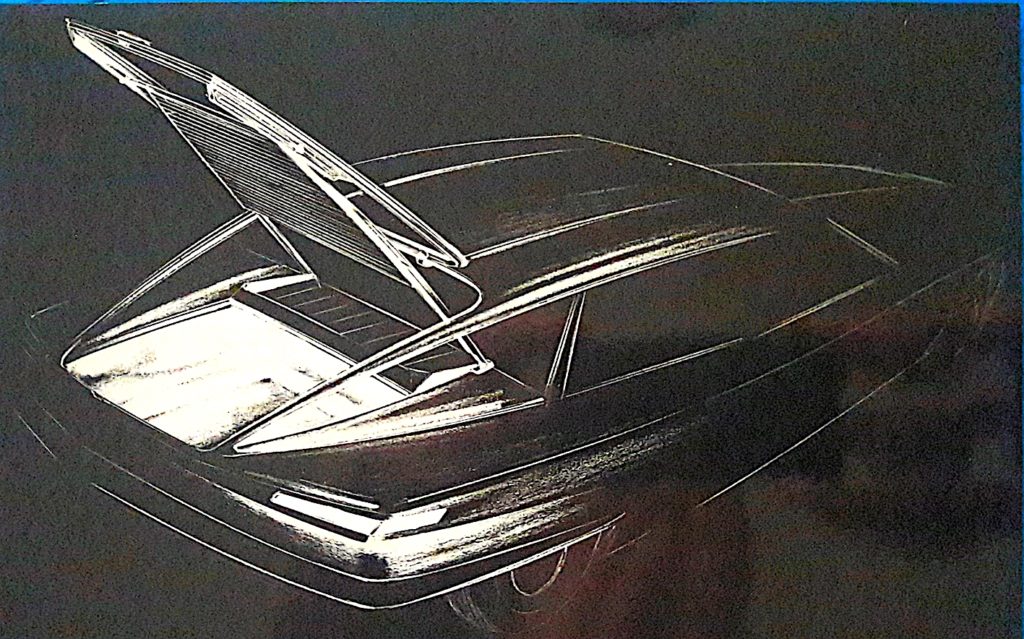
The 1960s were a time of constant technical development to boost the DS’s engines. But in terms of style, the Queen of the Road is the object of just as much research to improve the myth. But is it even possible?
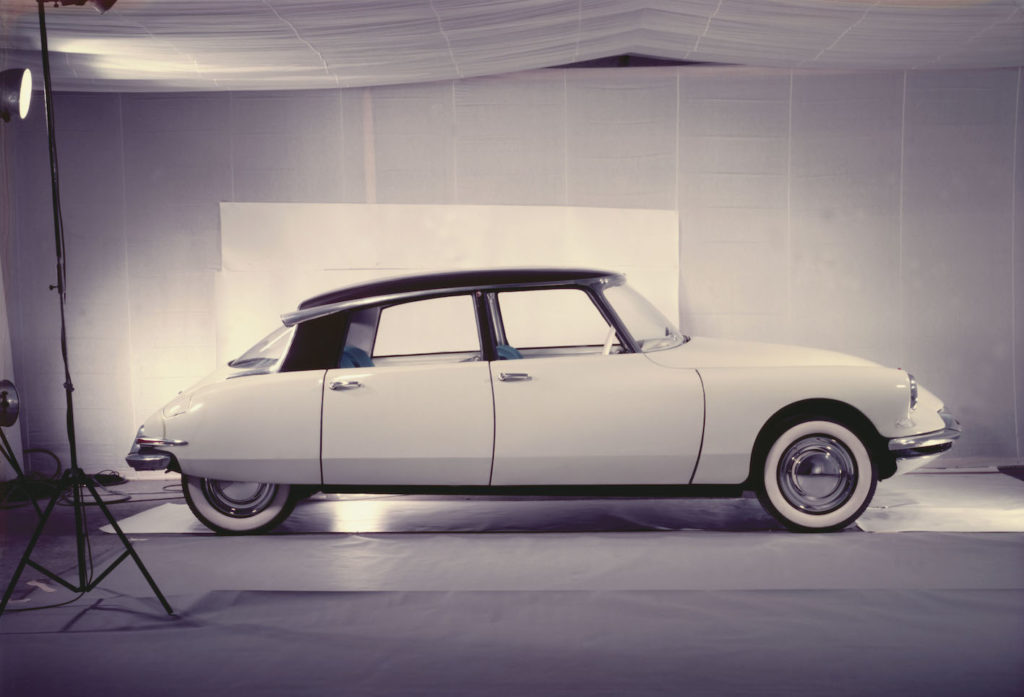
In 1965, Citroën’s design office was in a frenzy. There are a multitude of programs in progress. Technically, four-cylinder engines with double camshafts rubbed shoulders with rotary piston blocks on one side, while on the other, the “S” programme began to tapping the minds of the engineers who were pushed to the limit by the “F” project for the compact saloon.

The latter didn’t give the expected results on the test tracks at the “Ferté Vidame” center. And to dress up all this research, the team of stylists at the “rue du Théâtre” is in the midst of a process of reflection. In addition to all this work, there is a partial or total redesign of the Queen of the Road, the DS born just ten years ago and which has not the shadow of a replacement actuated by the management. So everyone goes ahead with their own proposal. Already in 1963, a few months before his death, Flaminio Bertoni was already hammering the sheet metal and plastering the plaster on a bare DS body. He never stopped thinking that his masterpiece was incomplete. Finished in a hurry just a few weeks before its industrialization, the style of the DS was notably frozen in its rear part in a definition that did not please the Italian artist.
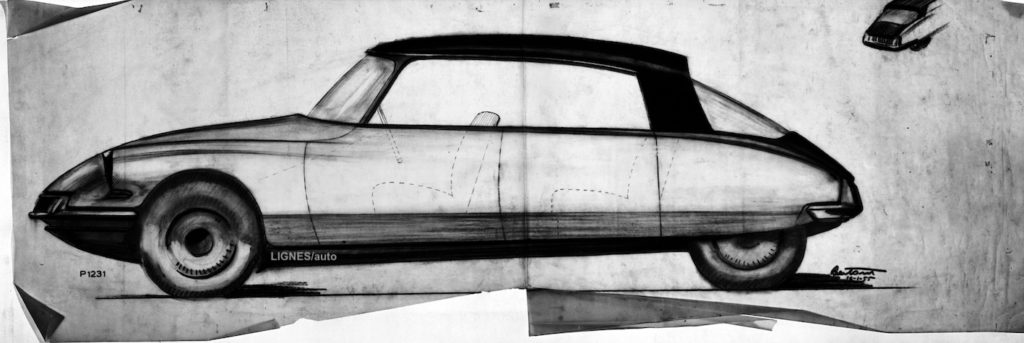
Yet it was on the prow that Bertoni was most relentless just before his death. And it is Robert Opron who confides to us that it was indeed he who “finished the job” for the restyling, but respecting Flaminio Bertoni’s idea. “At the time I told Pierre Bercot that the DS, this masterpiece, should not be touched. To which he replied that if the DS had been a masterpiece, it would have been copied! I was there for the restyling. Bertoni was furious that all the studies were going nowhere. I remember that one day Bertoni had a case of DS’s assembled in our premises without the mechanics. He broke a headlight on one side without removing the fender, which he destroyed with a sledgehammer. For an hour, with his plaster trough, he sculpted a new wing which was just a sketch for us but the idea was finally there!”
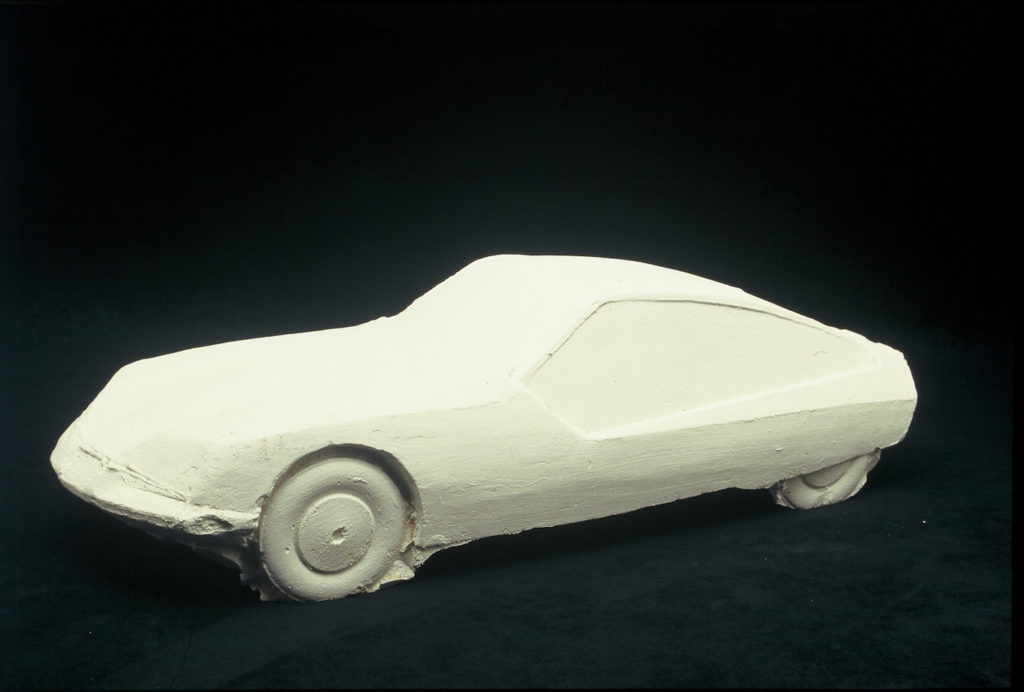
It’s hard to believe that the DS could have fished by its style. It was so out of step with the competition that customers found it irresistible anyway. Or they rejected it, depending on what they were looking for. But for the Citroën-style aesthete, it still needed to be refined. After Bertoni’s death, Robert Opron’s team of stylists set to work to try to give a fresh new look to a style that didn’t need it because it was timeless. Several projects emerge, between those concerning the “S” project (plaster model above) which will become the SM, and those trying to give back youth to the DS. It is not forbidden to imagine a successor to the DS, well before the official launch of project “L” of the future CX.
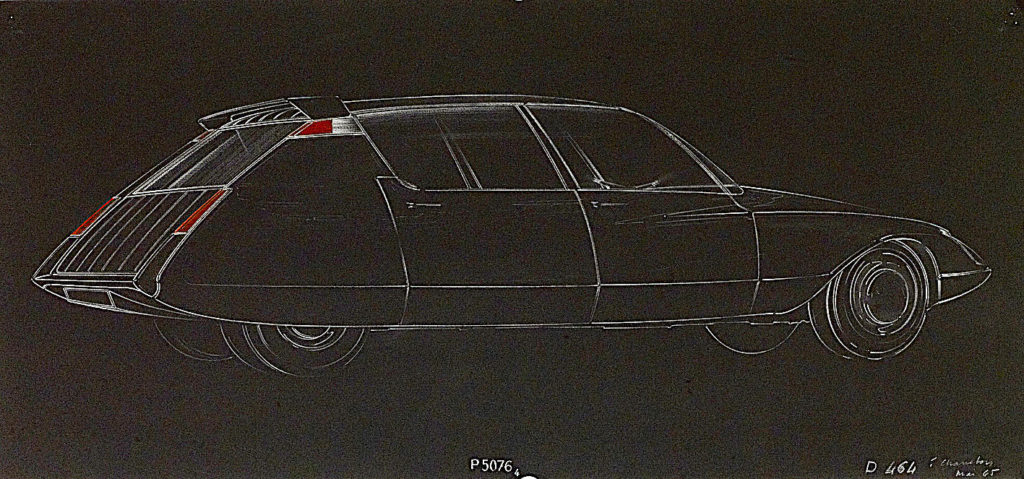
Thus, the stylist Jacques Charreton did not hesitate to break the entire stern of the DS to design an even more surprising one, in May 1965. The sedan you see above retains the thin window pillars of the 1955 DS as well as the turn signals on the rear panel. But this one is a generous stamping that rises up to the roof and falls steeply towards the rear bumper. The lights follow this slope and one wonders if Charreton had or had not imagined a tailgate on this vast sheet metal flap that acts as a trunk. The stylist invented the first DS hatchback!
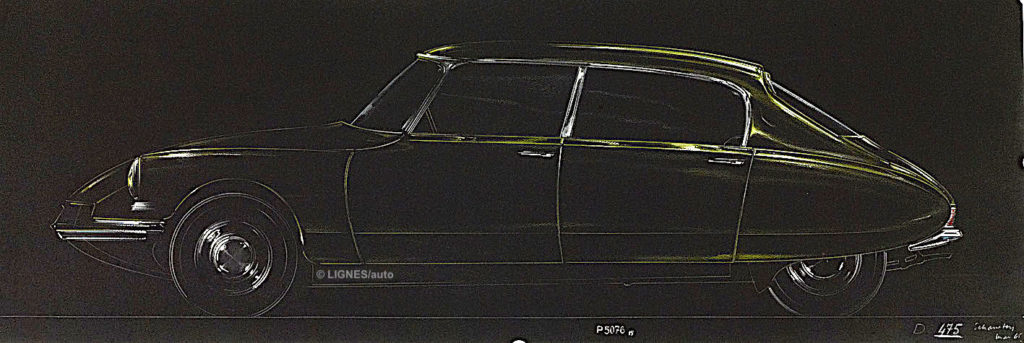
During the same month of May 1965, Charreton kept his idea of redesigning the entire rear part of the DS. Here are three of his proposals that we examine in detail.

This drawing by the designer Charreton is dated 1965. It tries to remodel the rear and only the rear of the DS.
1: The rear window is curved in its upper part. 2: The rear quarter panel is thinner and connected to the roof which seems to be made of sheet metal. 3: The window loses its impressive curvature for simplicity. 4: The trunk lid is tilted and falls very low on the bumper. 5: The rear wing is completely new, more curved. 6: The lights are grouped horizontally and rectangular in shape. 7: An aerodynamic element is upstream of the rear wheel.
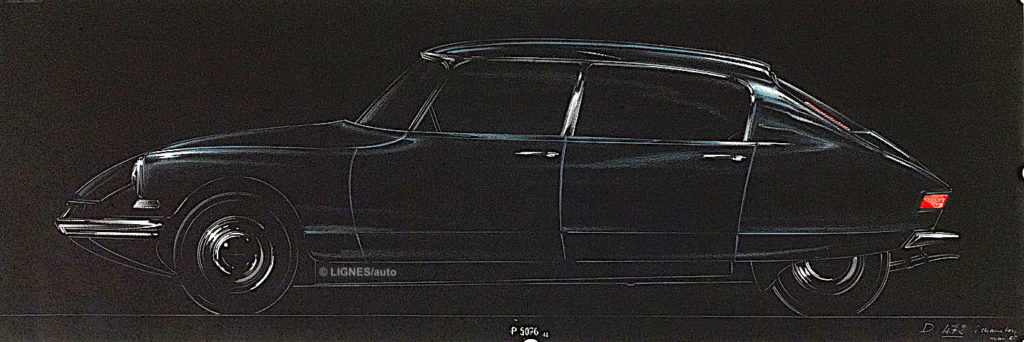
This second drawing treats the same part, always leaving the bow of the DS untouched.
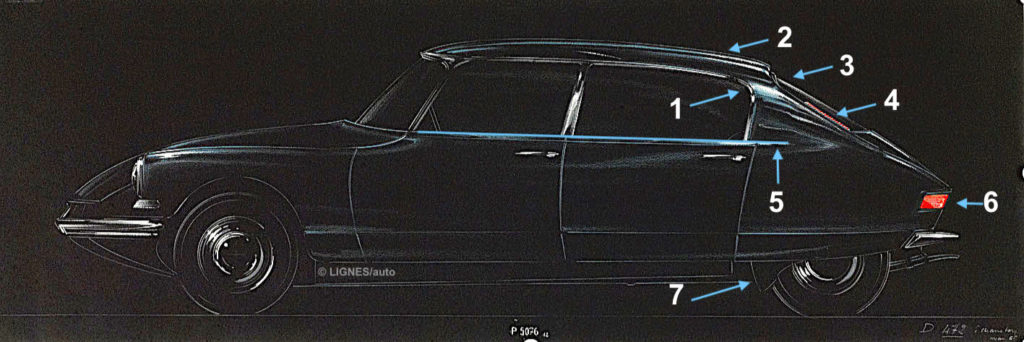
1: The rear window is always curved at the top. 2: The roof seems to be made of sheet metal. 3: As on the previous version, the window loses its impressive curvature for simplicity. 4: Difference with the previous design, a part of the lights (turn signals?) is raised on both sides of the window. 5: An elegant fold extends the rather horizontal body belt on the quarter panel. 6: The lights, rather bulky, overflow on the sides. 7: The aerodynamic element of the rear wheel is still present

This third proposal brings together the themes of the previous two. This drawing is still signed by Jacques Charreton.

1: The beltline doesn’t plunge like on the DS. 2: The tail lights seem to be positioned at two levels: at the edge of the window and the trunk. Is it a reflection simply for this last position? 3: The trunk lid is more curved and falls abruptly on the rear skirt. 4: The skirt is “tucked in” and is protected by an elegant bumper. 5: The aerodynamic skid in front of the rear wheel is still present.
AN EVEN MORE FUTURISTIC DS :
Still as prolific as ever, Jacques Charreton then designed a metamorphosed DS with a refined bow thanks to optics embedded in the wings. Already! (below).

The custodial post here turns into a fin. The quarter panel follows the slender movement towards this aerodynamic appendage and the thickness of the sheet metal accommodates the lights. One year after the death of engineer André Lefèbvre, the designers are paying him a heartfelt tribute by applying the basic principles of this science, principles that seem a little obsolete today!

1: Can the plunging front still accommodate the spare wheel? He opts for streamlined headlights. 2: The windscreen is more generous, curved and rises to the roof: maximum visibility! 3: The front door cut-out is dynamic, narrower at the bottom than at the top. 4 : The rear door cut-out is very modern and elegant. 5 : The aerodynamic element is this time integrated into the body design. 6 : The rear door pillar is raised, prefiguring the SM that will be born five years later. 7: Did the horizontally positioned chevron inspire Savignac for its “en avant Citroën” advertising campaign? 8: The roof seems to be totally transparent. 9: The spoiler protects the window from dirt and ensures (?) better aerodynamics. 10 : The the rear window seems to be totally vertical and the lights take place on both sides. 11 : The trunk lid is long and goes down in free fall. What about the aerodynamics? 12: Very nice cut of the rear wing at this level, very modern!

However, the magnificent spoiler (above) not only had aerodynamic virtues since it limited the soiling of the rear window, as Flaminio Bertoni imagined when he designed his inverted rear window on the Ami 6 (below) and as Robert Opron will also think of it for his CX, but with a much more elegant concave glass.
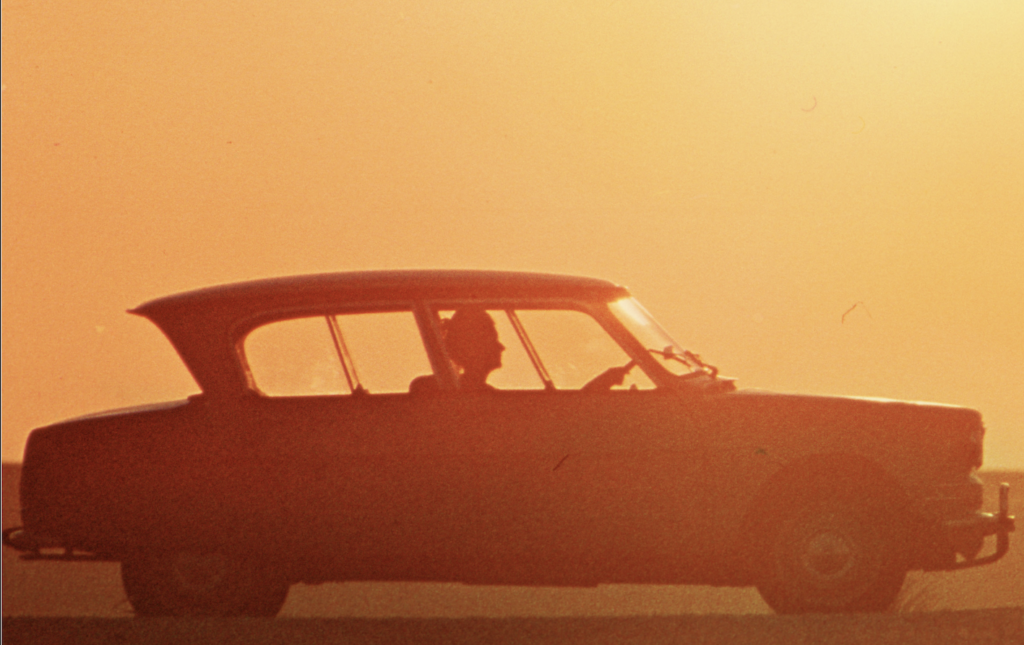
Finally, the restyled DS will see the light of day in 1967 for the marketing in 1968 , and it’s its additional rotating headlights that will make more ink flow than its style! As for the rear end, it has hardly evolved at all…


